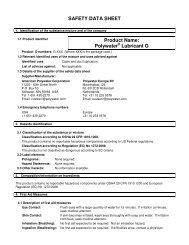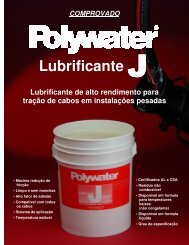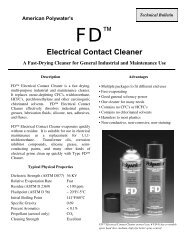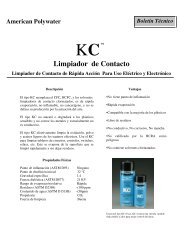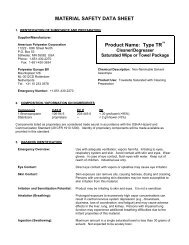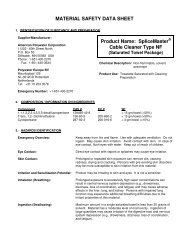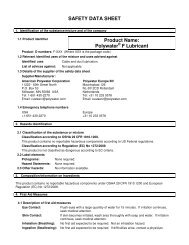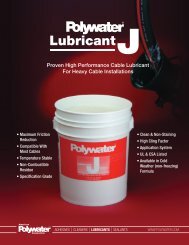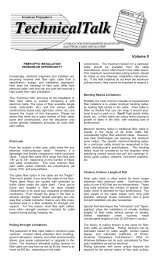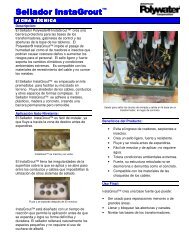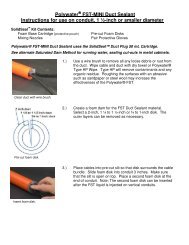Friction Table - American Polywater
Friction Table - American Polywater
Friction Table - American Polywater
Create successful ePaper yourself
Turn your PDF publications into a flip-book with our unique Google optimized e-Paper software.
<strong>American</strong> <strong>Polywater</strong>’s<br />
A Publication for Engineers Involved in Cable Installations<br />
Coefficient of <strong>Friction</strong> Measurement<br />
On <strong>Polywater</strong>’s <strong>Friction</strong> <strong>Table</strong><br />
<strong>Polywater</strong> maintains a leadership position in cable pulling lubricants by focusing on a lubricant’s<br />
primary function; the reduction of pulling tension and sidewall pressure through reduced friction.<br />
Lubricant “friction” is measured as a “coefficient of friction (COF)” or “friction coefficient”. The<br />
COF is a dimensionless constant that can be used to estimate cable pulling tension. Accurate<br />
friction coefficients are best measured using real cables, conduits, and lubricants.<br />
Several methods are used at <strong>Polywater</strong> to measure<br />
friction. One of the fastest and most convenient is<br />
called the <strong>Friction</strong> <strong>Table</strong>. Thousands of friction<br />
coefficients for all types of cable, conduit, and<br />
lubricants have been measured on the <strong>Friction</strong> <strong>Table</strong>.<br />
Most of <strong>Polywater</strong>’s pulling lubricants were optimized<br />
using this device. The <strong>Friction</strong> <strong>Table</strong> is the primary<br />
source for the friction database in the Pull-Planner<br />
2000 and 3000 (beta) Tension Calculation Software.<br />
How the <strong>Friction</strong> <strong>Table</strong> Works<br />
The basic <strong>Friction</strong> <strong>Table</strong> is diagrammed below:<br />
Pneumatic Pressure Cylinder<br />
Cable<br />
Normal Force<br />
Load Cell<br />
Pulling Force<br />
Load Cell<br />
Split Conduit (on <strong>Friction</strong>less Sled)<br />
Winch
1 2 3 4 5 6 7 8 9 1 0 1 1 1 1 1 1 1 1 1 2 0<br />
To make a measurement, a section of cable, typically 6 inches (152 mm), is placed on the split<br />
conduit. If the test is “lubricated”, the cable and conduit are coated with a thin film of the<br />
lubricant. While any type of cable and conduit can be used, the cable must be rigid enough to<br />
allow the conduit to slide without the cable bending back on itself.<br />
A pneumatic pressure cylinder pushes down on the cable and this “normal” force is measured<br />
with a load cell. A small winch pulls the conduit, and that force is measured with a second load<br />
cell. Note that the conduit is pulled under the cable. This makes no difference in friction<br />
determination, and enables data to be gathered with a relatively small piece of cable.<br />
The coefficient of friction is calculated using the equation:<br />
µ = F/N<br />
Where:<br />
µ is the coefficient of friction<br />
F is the measured pulling force<br />
N is the measured normal force<br />
Note that normal force also includes the weight of the cable. While this is often small compared<br />
to the measured applied force, it is added when significant.<br />
The normal and pulling forces are typically measured every 0.1 second and are recorded by a<br />
PC for calculation and analysis. Most frequently, the “average” friction coefficient over the data<br />
points is determined and used.<br />
Actual data from a single “pull” on the <strong>Friction</strong> <strong>Table</strong> device is shown below.<br />
0.16<br />
XLPE Jacket / PVC Conduit / <strong>Polywater</strong>® J<br />
20 Data Points at 0.1 Second Readings<br />
<strong>Friction</strong> Coefficent (Calculated)<br />
0.14<br />
0.12<br />
0.1<br />
0.08<br />
0.06<br />
0.04<br />
Averages<br />
Normal Force: 110.70 Pulling Force: 10.59 COF: 0.096<br />
Standard Deviation<br />
Normal Force: 0.90 Pulling Force: 0.35 COF: 0.004
Statistical Analysis<br />
While the COF data variance in the single pull above is low, this is not always the case. For<br />
instance, “non-lubricated” jackets can pull with significant variation (slip/stick).<br />
A typical data point is the average of 3 consecutive pulls. The variance pull to pull, while higher<br />
than in a single pull, still tends to be relatively low.<br />
However, a third source of variation can be more significant. This is the variation measured<br />
when multiple cable jackets in the same “generic” class are tested. For instance, PVC jackets<br />
vary significantly in formulation and demonstrate more variance in friction when all PVC jackets<br />
are averaged. Similarly, steel conduit, especially EMT (electro metallic tubing), shows<br />
considerable variance presumably from interior coating differences.<br />
It is important to realize that most <strong>Friction</strong> <strong>Table</strong> data are “averages”, and variance should be<br />
considered when the data are used.<br />
Kinetic Versus Static <strong>Friction</strong><br />
The <strong>Friction</strong> <strong>Table</strong> is set up to measure kinetic or moving friction. The discrete data sampling of<br />
the PC prohibits a determination of static friction. Regardless, kinetic friction results are the<br />
most useful and have provided the best correlation with measured tension in field cable pulls.<br />
Limitations of the <strong>Friction</strong> <strong>Table</strong><br />
While the <strong>Friction</strong> <strong>Table</strong> device has provided enormous insight on the variables affecting friction<br />
and tension, there are some limitations in what can be tested on the device.<br />
1. The friction table represents a well-lubricated condition. Things like lubricant carrying<br />
properties cannot be measured on the machine.<br />
2. While certain conditions (pulling through water-filled duct, etc) can be studied through<br />
repetitive pulls and comparative friction measurement, this is very cumbersome, and the<br />
results questionable.<br />
3. Small, flexible cables “bunch” and do not give good results on the device.<br />
4. The device only works with single cable, so variables like cable configuration or multi-size<br />
cables cannot be studied.<br />
5. While the device can be run in various ambient conditions, its use in hot or cold rooms is<br />
not practical, so the data represent typical laboratory temperatures of 68° F to 72° F (20°<br />
C to 22° C)<br />
6. While the normal pressure on the <strong>Friction</strong> <strong>Table</strong> can be adjusted, a great majority of the<br />
historical data has been taken with a normal pressure in the range of 100 lbs (445 N).<br />
While friction variation with normal pressure can be studied on the device, the use of low<br />
normal pressures raises the measurement variance significantly. So, normal pressure<br />
effects on friction have been studied via other methods.
General Results from the <strong>Friction</strong> <strong>Table</strong><br />
Analysis and presentation of all the data gathered from the <strong>Friction</strong> <strong>Table</strong> is beyond the scope of<br />
this paper. However, some generalized findings are highlighted below.<br />
Cable Jacket Effects<br />
Graph 1 shows average friction coefficients for various jackets in PVC conduit, both lubricated<br />
and not lubricated.<br />
Interestingly, the exposed lead jacket had the lowest non-lubricated friction, but when lubricated,<br />
it shows the highest friction. The data shows the importance of high-performance lubricants<br />
with the switch to plastic jacketed underground cables. While the non-lubricated friction of the<br />
plastics is high, the lower COF’s possible with <strong>Polywater</strong> ® Lubricant indicate the longer and<br />
lower-tension pulls that are possible.<br />
Note that non-lubricated friction and lubricated friction vary by jacket. While the highperformance<br />
lubricant <strong>Polywater</strong> ® J is an equalizer, there is still a range in lubricated friction<br />
(0.10 to 0.18) among these jackets.<br />
0.6<br />
Coefficient of <strong>Friction</strong><br />
0.4<br />
0.2<br />
Non-Lubed<br />
<strong>Polywater</strong>® J<br />
0<br />
Nylon XLPE PVC CSPE Lead<br />
Graph 1<br />
Conduit Effects<br />
Graph 2 shows average friction coefficients for PVC jacket in several types of conduit, again<br />
both lubricated and non-lubricated.<br />
As expected, non-lubricated friction is several times higher than lubricated. Also note that there<br />
is a difference in lubricated friction based on conduit type (in this case - 0.11 to 0.13).
Coefficient of <strong>Friction</strong><br />
0.6<br />
0.4<br />
0.2<br />
Non-Lubed<br />
<strong>Polywater</strong>® J<br />
0<br />
Steel PVC HDPE<br />
Graph 2<br />
Lubricant Effects<br />
Graph 3 shows average friction coefficients for PVC jacket in rigid steel conduit with 5 different<br />
commercially available pulling lubricants. While all the lubricants reduce friction (0.11 to 0.23),<br />
some are notably more efficient with this jacket and conduit combination.<br />
0.6<br />
Coefficient of <strong>Friction</strong><br />
0.4<br />
0.2<br />
0<br />
Non-Lubed<br />
Lube 1<br />
Lube 2<br />
Lube 3<br />
Lube 4<br />
Lube 5<br />
Graph #3
Summary<br />
The <strong>Friction</strong> <strong>Table</strong> offers a convenient and effective way to measure friction. Much has been<br />
learned on the device, including the extended pulling distances and lower tensions possible with<br />
<strong>Polywater</strong> ® pulling lubricants. <strong>Friction</strong> <strong>Table</strong> data can help plan and optimize cable installation<br />
in conduit.<br />
Topic Related Links<br />
Pull-Planner Software Literature<br />
<strong>Polywater</strong> Home Page Link<br />
Copyright © 2007. <strong>American</strong> <strong>Polywater</strong> Corporation. All rights reserved.<br />
12/2007



